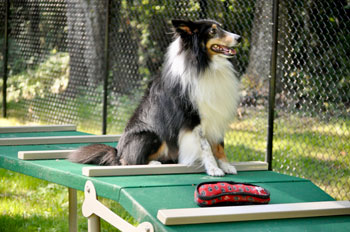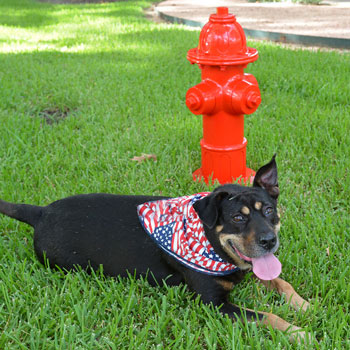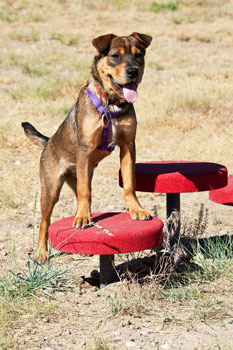According to the American Society for the Prevention of Cruelty to Animals (ASPCA), more than 23 million American households—nearly one in five nationwide—adopted a pet during the recent pandemic, with the majority of those pets being dogs. And while there were concerns that many of those pets would end up back in animal shelters, further ASPCA data from the summer of 2021 stated that 90% of new dog owners were not considering “rehoming” their dogs.
“Pandemic puppies were absolutely a thing,” said Nora VandenBerghe, managing partner of a Washington state-based designer and manufacturer of dog park products, who shared that her household welcomed another Great Dane pup to their own pack in 2020. She believes that the increase in the number of dog parks in the past couple years—and the number of existing parks making improvements—can be attributed to not only the number of families adding dogs who needed outdoor space to recreate, but also the fact that dog parks are a safe place to congregate. “They’re outdoors, there aren’t a lot of touch points like playgrounds or group sports, people are able to safely socially distance, etc. From a cost perspective, dog parks are much more affordable to outfit than other parks or ballfields as well.”

“It wasn’t just people adding dogs to their families, but also the increase of people working from home, which created the need for people to take a break,” said John Sarver, director of design at an Indianapolis-based manufacturer and retailer of dog park equipment, pointing out another way that the pandemic affected the way people utilize dog parks. “Dog parks have provided a great opportunity for someone working from home to take a breather and go to the dog park and socialize with their dog.”
“We see an increasing trend in public dog parks and a growth in municipal dog parks with all utilities,” Sarver continued, describing current “upward trends.”
Indeed, as the pandemic highlighted the importance of people getting outdoors and exercising, many cities and parks departments looked to capitalize on this mindset and enhance their offerings, which often included dog parks. Giving attention to some fundamental details will help draw people to these locations.
“A well-rounded park should have the core utilities, electricity for lighting, water supply for drinking fountains, and shade and shelter for protection from inclement weather,” said Sarver.
Dog park agility components including climbing structures, bridges, hurdles, jumps, balance beams, tunnels, barrels, ramps, hoops, weave poles and training platforms are also a good draw, and according to VandenBerghe, a good way to encourage human movement as well. “One of the main benefits of dog agility is the interaction between the guardian and their pet. As you’re making your way around the course or equipment with your dog, you are moving more than you would in a dog park without agility components.
“Our perspective is that dog parks are parks for people with dogs, so amenities for the two-legged visitors are a must,” continued VandenBerghe. “To encourage year-round use, adding safety features like solar lights is helpful, and creature comforts like adequate seating, protection from the elements, a hand-washing station or restrooms all help to draw people to the dog park, rain or shine.”
She added that a wide range of site furnishings—including seating, shade shelters, waste receptacles, water fountains and bottle fillers all “help make dog parks welcoming and more comfortable for everyone.”
Aside from the benefits of people getting fresh air and exercise, dog parks also enable socialization and connection among pet owners. And while VandenBerghe does believe that location is an important consideration for park planners, she has observed that dog park users are willing to drive out of their way to both exercise their dog and meet up with other park regulars.

“One of the great benefits of dog parks is that they really function as a social hub and many folks visit their local dog parks daily, which also means they see and get to know other people in the community. Something as simple as six- or eight-foot benches that have room for two people to sit comfortably can lead to conversations, as can finding a comfortable spot under a shade structure.”
Considerations in the planning and design phase can also foster human interaction, and Sarver suggested that integrating dog parks into other human venue areas can be a nice way to cross-promote various activities that bring humans and pets together. “One of the best ones is integrating dog parks into the disc golf parks where the dogs and their owners can play and walk together. Off-leash trail walking is another great way of doing this, provided the trails are fenced in and kept clean. For the safety of the dogs, it is important that any dog park area maintains a level of integrity with the enforcement of picking up waste, trash and other items that are not safe for dogs.”
Another way to promote socialization is to offer special programming or events, whether educational, promotional or strictly social. “Dog parks provide a great venue for things such as adoption events, meet-ups by breed or interest categories and local vendor sponsorship promotions,” said Sarver.
He added that dog parks can also get creative during holidays, and VandenBerghe agreed. “Because dog parks are typically highly used, programming—whether through the city directly or the group that manages the park—is a regular occurrence. We see a lot of holiday-themed events like ‘Howloween’ or photo ops with Santa, and other creative ways to fundraise while bringing people together,” she said.
One event that VandenBerghe said they recommend for a new park opening—if the park has agility equipment—is to bring in an agility trainer. “They can show park users how to safely enjoy the equipment and offer tips on dog handling, while they enjoy potential new business from the introduction,” she explained. “This also helps to provide a visual for people who may not be familiar with dog agility. Once they see how much a dog enjoys it, they’re much more likely to ty it themselves.”
In Whitefish, Mont., the Hugh Rogers WAG Park sits in the foothills of the Rocky Mountains. Named for a beloved local veterinarian who died in a plane crash in 2009, the off-leash dog park has grown to approximately seven acres and is part of the Armory Park complex, which features sports fields, a playground, skateboard park and picnic areas. The dog park features accessible paved paths, benches, drinking fountains for people and pooches, community pavilion, agility course, a pond with dog beach and a dog wash station. The entire dog park is fenced, and within that there are individually fenced areas, including one for smaller dogs.

The city of Whitefish owns the land, and manages the dog park jointly with the nonprofit Whitefish Animal Group (WAG), comprised of 15 dedicated volunteers. “The city maintains the lawns, irrigation system, snowplowing of the parking lot and supplies the park with (waste pickup bags) and garbage disposal,” said Ray Boksich, president of WAG. “WAG acts in an advisory capacity, and raises funds and provides leadership for future improvements as well as filling (pickup bag) stations daily, weeding and trimming, maintaining walking paths and holding volunteer cleanup days as needed.”
Boksich shared some of the many improvements they’ve helped spearhead since the park opened in 2009, including completing the swimming pond and beach area and constructing a landscaped creek bed for controlling pond levels that the dogs can also utilize. More walking paths were constructed, ingress and egress bullpens were added to avoid congestion and confrontations, and a dog wash area was built. An information kiosk was added and another storage shed installed so volunteers can access hoses, mowers, blowers, pickup bags and other supplies.
The popular obstacle course will soon be replaced by a larger one. “We hope to make it a very natural-looking area by using natural materials—rocks, stumps etc.,” said Boksich, who mentioned other future projects including a memorial area, additional shaded seating and more pet drinking stations.
When it comes to human socialization, Boksich said the community pavilion is a gathering spot to some degree, but visitors use it mostly to escape snow, rain or sun, often utilizing benches on the perimeter so they can keep an eye on their dogs. “The biggest gathering spot is usually in the center of the park where people will visit while their dogs are running around them.”
Depending on the time of day you visit the park, you will typically see some regulars, according to Boksich, who said the dynamic of the park users is interesting. “We have the early crowd (6 to 8), a mid-morning group, afternoon group and evening group. Usually these folks get to know each other quite well. You will often see them walking laps together and making plans to meet for other activities other than the dog park.”
He said people without dogs often visit as well, to walk the paths or sit by the stream or pond. After all, dogs do seem to give a mental boost to most everyone! A lot of travelers also visit the park with their furry friends.
Various events are held throughout the year to raise money, celebrate dogs and bring people together, including WAG Fest, though Boksich said the event took a hit during the pandemic. “It was a fun, carnival-type community picnic that was put on in conjunction with one of the local veterinary clinics. It was not a fundraiser, just a fun thank you to the community.” The WAG Race was used to raise funds for the park. Additionally, “We’ve been running some events utilizing social media for such things as Halloween, Thanksgiving, Christmas and Valentine’s Day.”
The nonprofit organization Trust for Public Land (TPL) releases an annual ParkScore report, which reviews data to rank the 100 most populated cities in the U.S. in different categories. And in 2021, Boise, Idaho, was the number one city for dog parks, with 6.3 parks for every 100,000 residents.
Bonnie Shelton is the communications and marketing superintendent for Boise Parks and Recreation, which oversees the dog parks. “Outside our designated off-leash parks, there are nine off-leash areas. Some are operated on a seasonal basis, outside of sports leagues, etc., and others are available during designated hours. All of these off-leash areas are located in existing parks,” said Shelton.
“We have definitely experienced an increased enthusiasm for dog off-leash opportunities at our parks. It gives people a reason to get outside, be active and many of our residents like exploring different off-leash parks and areas offered across our park system. Our winter seasonal off-leash program at regional parks Ann Morrison Park and Optimist Youth Sports Complex is extremely popular and very successful each November through February. People bring their dogs out no matter the weather!”
Shelton said they regularly hear from dog owners interested in additional places to take their pets to play. “We engage our residents in park planning processes across the city, and dog amenities are often requested through the master-planning process. Neighborhood associations can also apply for the city’s Neighborhood Investment Program to fund additional park equipment or upgrades, which could include dog park amenities.”
Pickup bags and trash cans are provided at all dog parks while other amenities vary by site, according to Shelton. Morris Hill Dog Park includes agility equipment, while Together Treasure Valley Dog Island has a water feature. “Dogs can run and play on the island and swim in the surrounding pond that is accessible by the banks and a ramp.” That location also has a couple picnic shelters in addition to other seating.
Surfacing at the dog parks varies. “Some have turf, others have a bark or chat mix,” said Shelton. “We often work with the neighborhood to determine what surface is desired, as long as it’s able to be maintained.”
And what about promoting human interaction? “We try to create gathering areas that are accessible within our off-leash dog parks,” explained Shelton. “For example, adding shelters or gazebos where people can escape the heat or rain and snow while their dog plays.”
And while Boise doesn’t currently offer regular events or programs at the parks, “there are annual events in our parks sponsored by outside groups that appeal to dogs and their owners. A good example is ‘See Spot Walk,’ benefitting the Idaho Humane Society.” Shelton added that several groups do organize cleanup efforts in the Boise foothills along popular trails each year. “One example is ‘Boise Gives a Crap,’ where volunteers meet at a trailhead and remove pet waste from along the trails.”
More private dog parks are opening their gates, and many of them are getting creative when it comes to offerings—including programs and social events—that might entice humans and inspire municipal park operators. Dog Mountain in St. Johnsbury, Vt., puts on numerous events, including a Golden Jubilee for golden retrievers and their friends, an annual celebration party for the park’s founders and special Dog Parties in the summer and fall. They also have art work spread around the grounds and a chapel for memorializing dogs.
The PETA-operated Bea Arthur Dog Park in Norfolk, Va., hosts a variety of events including a multi-shelter adoption drive called Poochella. In Ada, Mich., the Shaggy Pines Dog Park features an event space that also hosts agility and training classes. And their Coffee & Treat Bar serves both human and doggie goodies. And DOG PPL in Santa Monica, Calif., is referred to as a “canine social club,” complete with a lounge area, café and bar, and store. Events include Taco Tuesday and half-price margaritas, yoga classes, donation drives and holiday gatherings.
Both Sarver’s and VandenBerghe’s firms offer dog park planning and design services, and it seems these facilities are popping up in a lot of varied locales. “We’ve designed dog parks and play areas for municipalities, military/MWR, multifamily communities, RV resorts and campgrounds, shopping centers, airports, dog boarding facilities and animal shelters to name a few,” said VandenBerghe.
And as dog ownership climbs among all demographics, including many living in urban areas, VandenBerghe said that urban dog parks are very necessary for the health and well-being of people and their pets in large cities. “Living with limited outdoor space, a local dog park is often an important part of getting daily exercise and socialization. The city of Seattle has a very popular dog park tucked under an I-5 overpass along with several others in the downtown area.”
Sarver added that “We generally see dog parks incorporated into rooftops and parking structures where it is hard to find ground-level areas.”
Indeed, depending on available space, budgets, landscape features and community desires, a little imagination can go a long way. “I’ve visited dog parks throughout the U.S. that are often smack dab in the middle of it all,” said VandenBerghe. “Some of them are large and some are pocket parks—just a small area with a bench or two, a fire hydrant and a waste pickup station. Sometimes city planners do have to get creative as dog parks are often one of the most requested additions to a parks system.” RM


